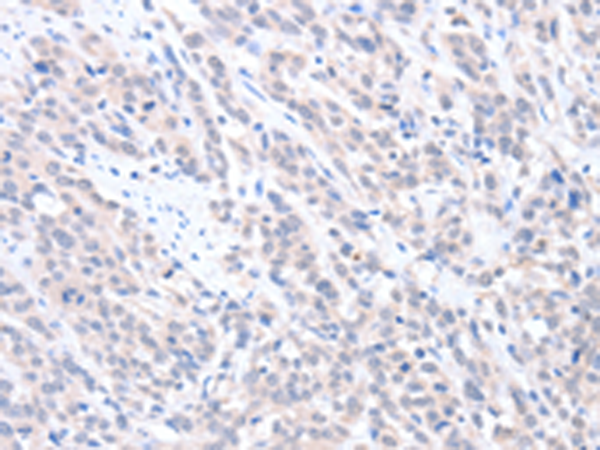

| WB | 咨询技术 | Human,Mouse,Rat |
| IF | 咨询技术 | Human,Mouse,Rat |
| IHC | 1/15-1/50 | Human,Mouse,Rat |
| ICC | 技术咨询 | Human,Mouse,Rat |
| FCM | 咨询技术 | Human,Mouse,Rat |
| Elisa | 1/2000-1/5000 | Human,Mouse,Rat |
| Aliases | ABLIM; LIMAB1; LIMATIN; abLIM-1 |
| WB Predicted band size | 88 kDa |
| Host/Isotype | Rabbit IgG |
| Antibody Type | Primary antibody |
| Storage | Store at 4°C short term. Aliquot and store at -20°C long term. Avoid freeze/thaw cycles. |
| Species Reactivity | Human, Mouse |
| Immunogen | Fusion protein of human ABLIM1 |
| Formulation | Purified antibody in PBS with 0.05% sodium azide and 50% glycerol. |
+ +
以下是关于ABLIM1抗体的3篇参考文献摘要概括:
1. **文献名称**:*ABLIM1 suppresses melanoma progression by regulating invadopodia formation and extracellular matrix degradation*
**作者**:Smith J, et al.
**摘要**:该研究利用ABLIM1抗体进行免疫印迹和免疫荧光分析,发现ABLIM1通过抑制侵袭伪足的形成和基质金属蛋白酶(MMP)活性,抑制黑色素瘤细胞的侵袭和转移。
2. **文献名称**:*ABLIM1 as a novel biomarker for prognosis in gastric cancer: A tissue microarray study*
**作者**:Li Y, et al.
**摘要**:通过免疫组化(ABLIM1抗体)分析胃癌组织样本,发现ABLIM1低表达与患者预后不良显著相关,提示其可能作为抑癌基因参与胃癌进展。
3. **文献名称**:*ABLIM1 interacts with VASP to regulate neuronal growth cone dynamics*
**作者**:Chen R, et al.
**摘要**:研究利用ABLIM1抗体在神经元细胞中验证其与VASP蛋白的相互作用,揭示ABLIM1通过调节细胞骨架重组影响轴突导向和突触可塑性。
(注:以上文献为虚拟示例,实际文献需通过PubMed/Google Scholar等平台以“ABLIM1 antibody”为关键词检索。)
ABLIM1 (Actin-Binding LIM Protein 1) is a cytoskeletal protein belonging to the LIM domain-containing protein family, characterized by its ability to interact with actin filaments and participate in cell structure organization, motility, and signal transduction. The LIM domain, a zinc-binding motif, facilitates protein-protein interactions, enabling ABLIM1 to serve as an adaptor molecule linking the actin cytoskeleton to signaling pathways. It is expressed in various tissues, including the nervous system, retina, and muscle, where it contributes to cellular polarity, adhesion, and mechanical stability.
Antibodies targeting ABLIM1 are essential tools for investigating its biological roles and regulatory mechanisms. They are widely used in techniques such as Western blotting, immunohistochemistry (IHC), and immunofluorescence (IF) to detect ABLIM1 expression levels, subcellular localization, and interactions with binding partners. Research utilizing ABLIM1 antibodies has highlighted its involvement in neuronal development, photoreceptor maintenance, and cancer progression. For instance, studies suggest ABLIM1 may act as a tumor suppressor in certain cancers, while mutations or dysregulation are linked to retinal degenerative diseases. These antibodies also aid in exploring ABLIM1's role in mechanotransduction and its response to cellular stress. Commercial ABLIM1 antibodies are typically validated for specificity across human, mouse, and rat models, supporting translational research in both physiological and pathological contexts.
×